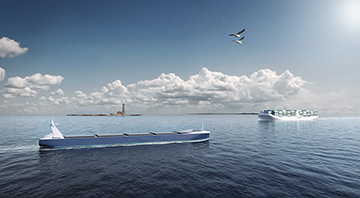
[Image: Rolls-Royce plc] [Enlarge image]
The British engine maker Rolls-Royce has announced that it is deepening its strategic relationship with Finland’s VTT Research Center toward the creation of a generation of remote-controlled and autonomous vessels for maritime shipment—so-called smart ships.
The strategic agreement reportedly seeks to combine the technologies and expertise that Rolls-Royce has developed in remote-controlled and autonomous shipping—an area in which it has invested heavily in recent years—with VTT’s strengths in Internet of Things technologies, in physical testing of marine prototypes, in data analytics, and in niche communications segments such as wi-fi mesh networks.
Rolls-Royce expects to leverage the partnership to rapidly prototype and test a new generation of such ships. And the company has framed an ambitious timeline; it hopes to deploy the first remote-controlled local vessels as early as the end of this decade.
Dramatic cost savings
While self-driving cars have been a fixture of tech headlines for years, the push for autonomous vehicles has also gained steam on the high seas, as worldwide shippers increasingly look to smart vessels for cost savings. The vision for autonomous shipping involves advanced platforms with highly evolved infrared detectors, high-resolution imaging systems and laser sensors that feed information, through high-bandwidth satellite communciations, into command-and-control centers that might be half a world away.
The technological timeline is expected to begin with remote-controlled vessels and culminate in fully autonomous ships, perhaps within as little as 20 years. It’s been estimated that the widespread use of smart ships could cut costs for shipping companies by some 22 percent. A large part of those savings, predictably, lies on the labor cost line, but some also come from reduced fuel costs due to increased efficiency.
Doubling down on automated shipping

Part of Rolls-Royce’s vision includes land-based control centers reminiscent of those in the film “Minority Report.” [Image: Rolls-Royce plc] [Enlarge image]
Rolls-Royce, a company whose name was once synonymous with the luxury car market, has staked much of its future on that kind of promise. And the firm has partnered with industry, academic and government players, particularly in the Scandinavian countries, to help realize the vision.
On that head, Rolls-Royce leads the Advanced Autonomous Waterborne Applications Initiative (AAWA), a public-private partnership founded in 2015, funded by Finland’s Tekes incubator funding agency and including both VTT and other Finnish university partners, as well as other industry partners such as Immarsat, which focuses on satellite communication technology. It also is working through several industry/government forums, including the Norwegian Forum for Autonomous Ships and a Finnish autonomous marine transport association, DIMECC, toward the goal of creating the first autonomous marine transport system, in the Baltic Sea.
The newly unveiled partnership with VTT extends the company’s activities with AAWA, and suggests that autonomous shipping development is moving out of basic research and into the testing and deployment phase. VTT has particular experience in shipping simulation, both with physical testing of models in tanks and with computer modeling and simulation, as well as extensive experience in the telecommunications networks that are central to a vision of self-driving ships. Rolls-Royce believes that the partnership will enable it to move rapidly to create and test prototypes toward the development of production models.
Drone ships by 2020?
Even with the most rapid prototyping, autonomous ships, like their self-driving-car cousins on land, face a number of challenges en route to broad deployment. Those include technical hurdles such as the ability to pass large volumes of sensor data in real time to distant command-and-control hubs. Recent developments in data communications and satellite technology are bridging some of those technical gaps, however.
A more daunting challenge could be political and legal hurdles related to the safety and security of the behemoth remote-controlled and autonomous marine platforms. These include international agreements requiring all ships to be “sufficiently and efficiently manned,” for example, and numerous questions regarding liability and other legal concerns.
Nonetheless, Rolls-Royce, at least, remains optimistic that the hurdles can be cleared. The marketing material for AAWA notes that the company “envisages a remotely operated local vessel being the first stage and in operation by 2020”—with remote-controlled coastal vessels in reach by 2025, remote-controlled ocean-going ships by 2030, and autonomous ocean-going ships by 2035.
